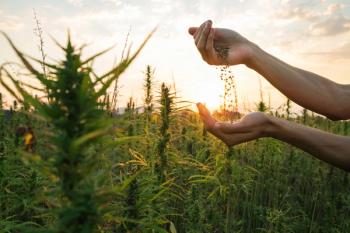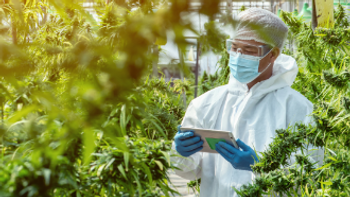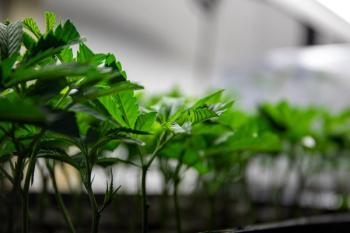
Cannabis Science and Technology
- September 2021
- Volume 4
- Issue 7
Does Light Spectrum Alter Plant Transpiration Rates?
Part III of this series explores the impact of light spectrum on plant growth and the equipment needed for indoor cultivation.
This article series explores some of the more technical aspects of cannabis cultivation that growers should understand to run their businesses more efficiently and more profitably. Part III explores the impact of light spectrum on plant growth and the equipment needed to condition an indoor cultivation operation. Light is the primary driving force of transpiration in plants, which means growers must equally consider factors like spectrum, form factor, efficiency, and intensity.
In the last couple of decades, plant-growth lighting technologies have become increasingly diverse in the pursuit of increased photosynthetic and energy efficiency. However, legacy technologies like high-intensity discharge (HID) lamps have remained the tried-and-true approach for supplying or supplementing light to crops, regardless of innovations in semiconductor light sources—primarily due to initial capital expenditure. The majority of information available when it comes to comparing the growth spectrum of these new and conventional light sources has been fixated on the impact on yield, chemical profile, and energy efficiency. For commercial cannabis grow rooms, this only provides a narrow scope to analyze the impact light spectrum has on plant growth and the equipment needed to condition the space.
New companies are constantly joining the market who make many different claims as to why their products are superior. Without equally considering spectrum, form factor, efficiency, and intensity, there is no way to know how each fixture will impact your plants and, subsequently, the conditioning of your grow room.
How Light Impacts Transpiration Rate
Light is the primary driving factor for transpiration in plants. Keep in mind that when we refer to light, we mean radiation, and not all forms are visible. As discussed in
Light can either be absorbed as energy (for photosynthesis or as a heat source) or perceived as a signal. A range of wavelengths abundant in one light source could signal the plant to transpire more (light-emitting dioed [LED] fixtures with a high blue fraction), while another may physically heat the plant up causing it to transpire more (high-pressure sodium [HPS] lamp)—or both! These spectra are also major contributors to growth and photosynthesis, demonstrating how intertwined these processes truly are.
Forget about yield for a moment and consider the cost of production. If one light source caused your plants to transpire 10% more than another, this could mean a considerable shift in how your cannabis climate control equipment is tailored to reach your setpoints and maintain them consistently throughout light and dark periods of growth.
Exploring the Difference Between Sunlight, HPS, and LED
There are some key differences between the spectral and physiological impacts of sunlight, HPS lamps, and LED fixtures on plants. When comparing LED fixtures and HPS lamps, we must consider not only performance in terms of driving plant growth and development, but also the variable initial costs and direct and indirect effects on energy use (which will also contribute to cost).
HPS lamps have been the industry standard for sole-source and supplemental lighting for some time now, but LED fixtures offer much more flexibility in light spectrum and many are more efficient in terms of photon efficacy—how much photosynthetic light is emitted per joule of input energy (µmol PAR/J). Luminaire manufacturers can use many different LED chips that can be customized to emit various narrow-band or broad spectra, whereas HPS lamps only vary slightly depending on whether they are double or single-ended. HPS lamps emit high amounts of photosynthetically active radiation (PAR) and a large amount of infrared (IR, a form of light that cannot be seen without an IR radiometer or a pair of night vision goggles). Infrared does not contribute to growth directly. Most light output from an HPS lamp is in the green to amber range (500–600 nm) and tapers off in both directions along the electromagnetic spectrum, spiking again in the near-infrared range. Broad spectrum LEDs also provide this range of PAR, but the main difference lies in the proportion of blue light (400–500 nm) and the ratio of red (600–700 nm) to far red light (700–750 nm).
Plants grown under LED fixtures are exposed to virtually zero direct infrared radiation, which is a novel experience compared to the conditions they are typically accustomed to in nature. HPS lamps emit quite a bit of infrared radiation, which is why they get so hot and why you can feel a warming effect when you are underneath them. As mentioned in
LEDs have a high fraction of blue light, which induces stomata to stay open. However, since this is paired with almost zero infrared, the plants stay very cool and room temperature needs to be kept much higher at 27–30 °C (80–86 °F). To make things even more complex, green light reverses the stomatal opening effect of blue light. More research is needed in order for us to fully understand how this impacts transpiration directly and how this differs in the presence of infrared light, but it certainly seems that this is a contributing factor to the temperature tolerance differences we see in HPS and LED grow rooms.
Temperature and Light Source
Plants grown under LED fixtures typically have a lower leaf temperature relative to the room temperature, while those under HPS lamps will be at or above room temperature. Light intensity dissipates quickly as you move further away from an HPS lamp and even more quickly when moving further from an LED fixture. HPS lamps emit a massive amount of light out of one central source, while most LED fixtures are a chipboard made of many low-wattage diodes that do not have quite as much penetration into the canopy. With sunlight—the biggest of all grow lights—the light intensity will be about the same whether your plants are grown 100 feet off of the ground or two because we exist in such a small fraction of the sun’s light spread (similar to a particle of dust floating under a grow light). Very high altitudes do see some difference in both solar spectrum and intensity.
Due to this attribute of electric light sources, the lower leaves of a plant can have a drastically different temperature than those closer to the light source. This increases the need for effective convective airflow in a grow room, which we will cover in our next article. It is important to note that when growing under high-intensity electric light sources, if CO2 concentration is not increased, high temperatures can be stressful for plants because it will increase oxygen solubility, encouraging photorespiration (refer to our discussion on RuBisCO in our
Impacts on Environmental Control
The impact of light spectral changes on plants have large implications for environmental control in commercial cannabis grow rooms.
HPS lamps are constantly heating the space and the fraction of infrared requires that room temperatures be kept cooler to avoid stressing plants. This means that the environmental control equipment needs to compensate for the increased heat load in the space. The efficiency of heat and water removal is higher when the grow room remains at a higher temperature due to the nature of refrigerants and the ability of compressors to maintain low coil temperatures. The higher the temperature of the room relative to the temperature of the refrigerant, the more capacity for heat and moisture removal the refrigerant will have. When servicing rooms at lower temperatures, the tonnage of the compressor must be sized larger to have enough capacity to remove the moisture and heat (which heats the refrigerant). This heat can be rejected outside, or it can be added back to the air to warm it back up after the moisture has essentially been “squeezed out,” resulting in a net reduction in humidity of the supply air.
LED fixtures permit the room to run at higher temperatures, which creates a larger gap between the temperature of the refrigerant and the return air, allowing for a higher rate of moisture removal (meaning less tonnage). It is also important to note that LED fixtures usually have a higher fraction of blue light (there are some exceptions), which—as mentioned—induces stomatal opening, resulting in an increased transpiration rate. It is possible for this effect to result in a higher moisture removal requirement depending on the canopy pruning practices and how much leaf area is present in the grow room.
There are different arrangements of plant-light source separation in a grow room that can completely change the heat load inside of a grow space. HPS lamps need to be kept further away from plants relative to LED fixtures in general, but among different types of LED fixtures this tolerance can change (it also depends on the form factor and overall power). One of the largest reductions in energy usage and overall heat load generated in a grow space is the usage of close-canopy lighting. All light sources generate heat, but the type of heat—be it radiant or simply a by-product of resistance in electricity-photon conversion—determines the impact on a grow room. There are LED fixtures that utilize a high quantity of low wattage diodes spread over a large area, creating a very high light intensity, but the peak is maybe six inches from the fixture and—if used appropriately—can provide equal light intensity at a much lower wattage compared to light sources that emit light from a concentrated source. However, light reflection and diffusion resulting from mounting fixtures far above the canopy improves canopy penetration and lower canopy and bud development at the cost of additional electricity.
In Conclusion
In the end, all energy put into a sealed grow room—no matter what form—will eventually become heat whether it is sensible (temperature increase) or latent (moisture increase). Photons lose energy every time they interact with a surface or object and that lost energy becomes heat. This concept is similar to how an oven stays hot even after it has been turned off for some time. The oven isn’t full of hot air that needs to get out, but rather the surfaces in the oven are full of energy and that energy is released as longwave radiation, which is infrared.
All objects, surfaces, and organisms emit infrared when they are excited with energy. This includes plant leaves, which—in addition to transpiration—cool off by releasing energy as longwave radiation or convective transfer to the air. If you supply a grow room with only shortwave radiation, which only includes PAR, far-red, and near-infrared (NIR), those photons are either going to be absorbed by water in the plant, absorbed by the plant for photosynthesis, or they will remain trapped in the room bouncing around from surface to surface and increasing in wavelength. This happens instantaneously relative to us since light moves so quickly, and environmental control is the only way to move it out of the room. LED fixtures permit lower overall energy input (virtually all of which will become heat) if they are used in a way that provides plants with the same light intensity at a lower wattage, which usually means close-canopy lighting. Infrared radiation from a light source heats up plants, causing them to transpire more. Blue light signals plants to transpire more, and green light can reverse this effect.
In short, it is clear that light spectrum does alter transpiration rates. We are working to determine the exact differences it creates and how that is considered when sizing equipment to condition plant-growth environments. Cannabis grow room operators must take these factors into account when choosing equipment to optimize plant growth and vitality.
References
- R. Batts and S. Burgner, Cannabis Science and Technology 4(2), 32-34, 38 (2021).
https://www.cannabissciencetech.com/view/why-does-leaf-temperature-matter-in-a-commercial-grow-room . - R. Batts and S. Burgner, Cannabis Science and Technology 4(4), 29-32 (2021).
https://www.cannabissciencetech.com/view/a-deep-dive-into-vapor-pressure-deficit-for-commercial-cannabis-cultivation .
About the Authors
ROBBIE BATTS is a passionate engineer with more than a decade of experience designing, selling, and commissioning HVAC and process systems throughout North America. Recognizing that there is a knowledge gap around fully understanding plant transpiration rates and how they impact controlled environments, he co-founded
Direct correspondence to:
How to Cite this Article
R. Batts and S. Burgner, Cannabis Science and Technology 4(7), 38-42 (2021).
Articles in this issue
Newsletter
Unlock the latest breakthroughs in cannabis science—subscribe now to get expert insights, research, and industry updates delivered to your inbox.



